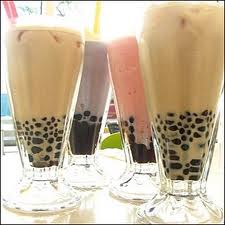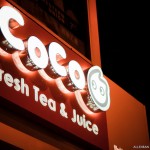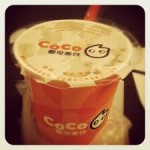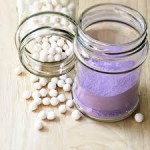 I’m not sure how far bubble tea has made it out of our big cities. In case it hasn’t made it to your locality: bubble tea, invented in Taiwan in the ‘80s, is tea (sometimes kinda maybe) that is filled with tapioca balls, which are little gelatinous spheres approximately a quarter inch in diameter. Bubble tea is thus usually served, whether hot or cold, with oversized straws that can accommodate the “bubbles.” These straws are typically whimsical shades of purple or pink or green. The cups are frequently adorned with cartoon creatures that defy classification except to say that, by virtue of including features like a single eye or a blob shape or the power to bounce and blink without the use of any limbs, they are distinctly Contemporary Asian. The only Western cartoon counterpart I can think of is the blob that used to bounce unhappily beneath a rain cloud in that Zoloft commercial.
I’m not sure how far bubble tea has made it out of our big cities. In case it hasn’t made it to your locality: bubble tea, invented in Taiwan in the ‘80s, is tea (sometimes kinda maybe) that is filled with tapioca balls, which are little gelatinous spheres approximately a quarter inch in diameter. Bubble tea is thus usually served, whether hot or cold, with oversized straws that can accommodate the “bubbles.” These straws are typically whimsical shades of purple or pink or green. The cups are frequently adorned with cartoon creatures that defy classification except to say that, by virtue of including features like a single eye or a blob shape or the power to bounce and blink without the use of any limbs, they are distinctly Contemporary Asian. The only Western cartoon counterpart I can think of is the blob that used to bounce unhappily beneath a rain cloud in that Zoloft commercial.
Bubble tea, in short, is meant to be fun. It is to tea what a Frappaccino is to coffee.
And it is just one kind of many tea drinks I have discovered living in a city with a large East Asian population. Bubble tea seems to frequently contains no real tea. Other “tea” drinks served either at tea shops or Chinese bakeries contain only milk or something called “creme” or water mixed with assorted powders the color of Willy Wonka products.
One of my favorites is sesame black milk tea. It involves steeping a black tea bag in a cup of hot water and milk and stirring in some kind of magic sesame powder. I had that again the other day while eating a Chinese cream bun that immediately made me feel as if I had swallowed half of a Macy’s Thanksgiving Day Parade balloon.
But sometimes I’ll look at the menus of Chinese tea drinks around town and get overwhelmed. The assemblage of parts indicated in the descriptions—Fresh lemon black milk tea with grass jelly and red bean, for instance—can defy all experiential understanding of how descriptive words can be assembled into the complete communication of a drinkable product.
So I’ve decided to embark on a small series investigating these Wonder Teas.
Entry One: Taro
I work at Baruch College, which enrolls a huge number of Chinese and Chinese-American  students. Across from an entrance to one building is a CoCo Fresh Juice and Tea franchise. When classes get out, this place may as well be giving away Walter White’s blue in a county too broke even for Appalachia.
students. Across from an entrance to one building is a CoCo Fresh Juice and Tea franchise. When classes get out, this place may as well be giving away Walter White’s blue in a county too broke even for Appalachia.
To fully appreciate CoCo, you really should check out its website. It makes Hello Kitty look grave. The shop itself plays sunny dance music at a volume that forces you to carefully balance on the edge between talking and screaming to the young woman taking your order. The boys working their asses off have Korean popstar haircuts. Once your drink is prepared, they insert it into a machine that reminds me of the plutonium catch in  the Back to the Future DeLorean. The machine seal the top of your cup with a plastic cover adorned with the CoCo blog. Super cu-u-u-u-ute!! It makes me ready to flash the peace sign in a photo with strangers in a strange country.
the Back to the Future DeLorean. The machine seal the top of your cup with a plastic cover adorned with the CoCo blog. Super cu-u-u-u-ute!! It makes me ready to flash the peace sign in a photo with strangers in a strange country.
The taro plant is a tuber. It’s a common ingredient in dishes all over the world. I don’t know how much of an ingredient it is in actual taro milk bubble tea, however. Being an American, I routinely eat foods the contents of which I have not the slightest clue. Ordering 16 ounces of taro milk tea yesterday acutely reminded me of this fact. What the hell is in this? My 16 ounces were sweeter than half of a birthday cake and filled me up about as much. There was no discernible taste except sweet. There’s not even the broad sweetness of sugar, let alone sugar mixed with other spices that give our different sweet foods distinctive tastes. No, this sweet was simply “sweet.” I couldn’t diagnose the actual taste of it any more than I could diagnose the taste of MSG.
Why taro? Well, the powder base the boys scooped into my cup was the dark lavender  shade of something out of a pack of Lick em Sticks. I suspect this color is why I ordered taro tea in the first place, itself an acute reminder that, for all of my attempts to battle away the marketing gurus who know our psychologies better than we do, I still can be snagged from my guarded perch.
shade of something out of a pack of Lick em Sticks. I suspect this color is why I ordered taro tea in the first place, itself an acute reminder that, for all of my attempts to battle away the marketing gurus who know our psychologies better than we do, I still can be snagged from my guarded perch.
Numerous calls of concern have been raised about contaminated powders in these teas, claims that various substances banned in Europe or the U.S. are being snuck into the mixes. That sounds about right. It reminds me (So many reminders from such a little tea!) that China is the Great American Wild West of our current era.
Having satisfied my purple fetish, I’ll move on to the next Chinese tea drink. I think I’ll have to avoid CoCo, however. You buy a tea at a Chinese bakery and they ask you how much sugar you’d like. You can get some actual taste.
CoCo, though, just sells its drug.
Which is fine. What’s an American college experience without drugs?

good read!